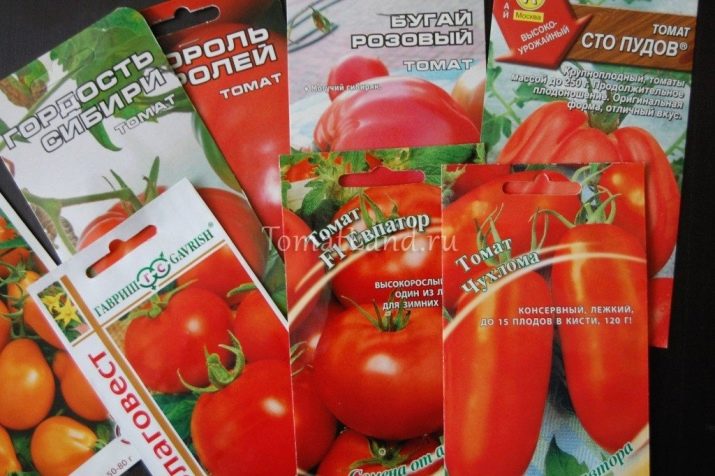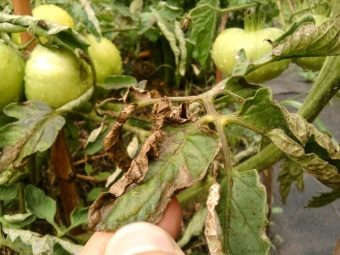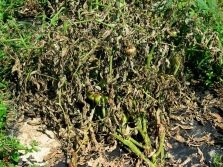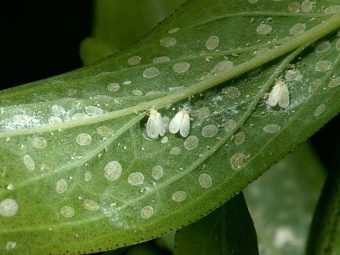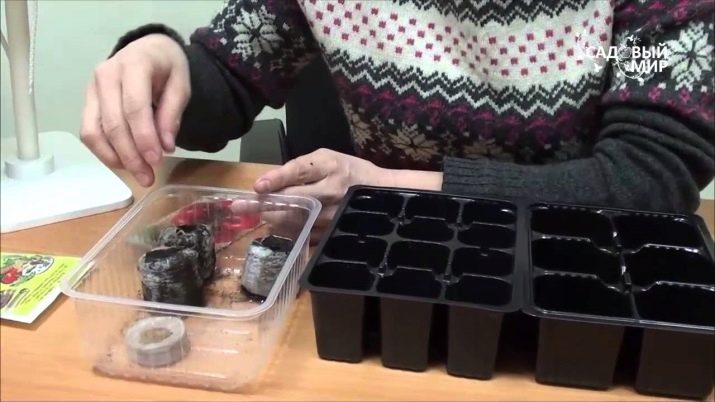Tomato seedling: instructions for growing and peculiarities of care
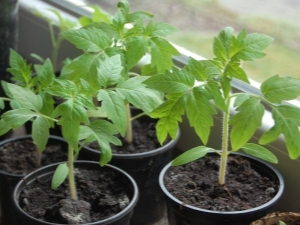
Today, for many, gardening is considered to be the most favorite activity, since thanks to this uneasy occupation it is possible to grow various vegetables and provide the family with vitamin reserves for the whole year. Particular attention among the vegetable crops occupy tomatoes. They are not only decorative, but also useful for human health by the plant. They are usually planted out of seedlings, so in order to achieve a high yield you need to know how to sow the seeds and care for the seedlings.
Variety selection
Before sowing tomatoes for seedlings, it is necessary to determine their variety and purchase quality seeds. But this will not be easy to do, since recently the market has been represented by a huge assortment of planting material. To properly navigate in this large range, it is important to consider the following nuances:
- Climate zone. Recently, many hybrids and varieties adapted for planting in various regions can be found on the market. As a rule, tomatoes with powerful foliage are planted in the southern zones, they are more resistant to heat and their life processes are slower than in tomatoes intended for the northern regions. Tomatoes that are grown in the North, on the contrary, more quickly form the crop and have a minimum foliage area in order to get maximum illumination for fruit ripening. Therefore, for the northern and central areas, it is best to choose varieties such as "Blizzard", "Wind Rose", "Alaska" and "Snowdrop".
For land plots located in the South and in the Black Sea coast, Fakel, Agata, Liana and Dar Trans-Volga tomatoes will be a good option.
- Landing site. Tomato seedling can be grown in greenhouses and in the open field. If it is necessary to get early and ultra-ripe tomatoes, then they should be planted in greenhouses, and then planted in open ground. These are universal plant species, they are also called super determinant. There are also crops that are intended only for greenhouses - interminant, and only for open ground - determinant. If there is no summer cottage, then tomatoes are quite realistic to grow on the balcony or loggia, picking up compact varieties.
- The term fruiting and ripening. In this case, the choice depends on how early the gardeners want to see on their table “vitamin beauties”. Many prefer early ripening plants, and some plant tomatoes with a longer growing season.
- Requirements in care. Despite the fact that most tomatoes are unpretentious in cultivation, they still need to be formed, tied up and stitched, and this entails a certain amount of time. Therefore, busy gardeners are best to choose low-growing bushes, because of the high varieties will require additional care and if it is not done, the crop will be scarce. Plants that do not need to be staked are considered ideal. Due to their small growth, there is also no need for garter stalks.
- Appointment of fruits. Tomatoes are divided into dessert (salad), for canning, for storage and universal. They all differ in the size of the fruit, density, pulp and skin strength. Tomatoes of large varieties, as a rule, have excellent aroma and taste, so they are used fresh. Late-ripening tomatoes are characterized by small dense fruits and are stored for a long time. And fruits with an oval shape are most often used for canning, as they are convenient for packaging.
- Resistance to diseases and pests. This indicator is one of the main ones, because many varieties quickly give in to such a disease as late blight and quite unexpectedly healthy and green bushes in one day can become covered with brown spots and die.To avoid this, it is recommended to acquire seed material that has protective functions to the late blight. "Explosion", "Oak" and "Kizima" have proven themselves well.
- The shape and color of the fruit. Recently, you can find tomatoes of different colors: yellow, white, red, striped, black and orange. The most common forms are oval, round and flat-round; pear-shaped fruits also look interesting. All of them have different maturity and taste.
In addition, in the sale, in addition to varieties, there are hybrids. Unlike the first, they are much more expensive, have high yields, are resistant to external factors and diseases, but of them it is impossible to obtain seeds for further planting.
Therefore, before making a choice in favor of a variety, you should weigh all the pros and cons.
Seed and soil preparation
When the issue of sowing material is resolved, you need to properly plan the entire planting process of plants. To do this, first determine the place on the site. It is desirable that it be sunny, protected from drafts and accumulation of excessive moisture. It is not recommended to plant tomatoes on the slopes near the placement of groundwater, there will always be damp and cool. In addition, the type of soil should be determined. Black, fluffy soils are well suited for cultivation; loam is also a good option, in which organic matter is plentifully added.
It is worth noting that the preparation of the soil for sowing seeds differs in many respects from the activities for the preparation of open ground. Therefore, in the first stage, it is enough to purchase ready-made earthen mixture in the store and sow sunflower seeds into it, and when you need to start planting seedlings, you will have to prepare the soil in autumn and spring. After harvesting in the fall, the earth is carefully removed from debris and plant residues, then it is blocked to a depth of at least 25 cm, throwing layers. In the case when the soil is too heavy, then one bucket of sand is added to 1 m2, so the soil will be not only light but also fertile. The increased acidity of the soil is removed by digging, during which 0.5 kg of lime is added to 1 m2.
In the autumn, organic elements in the form of humus, compost and manure are also laid. The cultivated land is left in a state of accumulation for the whole winter, this will allow it to absorb moisture well and destroy all bacteria under the influence of frost.
In the spring, it is necessary to re-dig or break through the soil and add 20 g of saltpeter, potassium chloride and 50 g of superphosphate to 1 m2. All of the above activities are very important, because thanks to them the unformed root system of seedlings will be able to receive all the necessary microcomponents for nutrition from the ground. Plants will quickly form and give a good harvest.
As for the preparation of soil in greenhouses, it is similar to that performed for open soil. The soil before planting is carefully dried and fed with minerals.
After the seeds have been acquired and the land plot is ready, you can safely proceed to sowing, having previously processed the planting material. For this, the seeds for several days before planting are immersed in saline solution and in this way unsuitable samples are determined, which usually differ in appearance and float. Then the seeds are further treated with a solution of potassium permanganate, dropping them into the mixture for 25 minutes. After disinfection, the samples are soaked in ordinary water and left to swell, it usually takes no more than 10 hours.
Planting dates
Planting tomatoes is carried out in a certain period, with the majority of gardeners are guided not only by the sowing calendar, but also the climatic features of the region in which the land plot is located. Typically, tomatoes are sown 60 days before planting.If this is done earlier, then bad results are possible: overgrown plants will not take root well, they will be unstable to low temperatures and the ovary will die. Therefore, many start growing tomatoes when the earth is already well heated and there is no threat of frost. As a rule, these terms fall on the beginning of February in the southern territories and the end of March in the northern.
A huge role in choosing the date of sowing is played by the variety of tomatoes. Tall plants are planted from February 20 to March 10, mid-season and early - from March 10 to 22, ultra early - from April 8 to 14, and large late-ripening - in the third decade of February. To determine the sowing time on your own, you should focus on the tomato growing season. In hybrids and early varieties, it is about 100 days, not including the time it takes to shoot.
Some experienced gardeners sow seeds for seedlings, adhering to the lunar calendar, but given the planted planting in a greenhouse or on open soil. Under the film, the plants are sown in the second and third decade of March, for the greenhouses the end of March is suitable, and the early tomatoes are planted on open soil in early April. In addition, the sowing time is indicated on the seed labels.
How to sow?
In order for self-cultivation of tomatoes at home to bring the expected results, it is necessary not only to sow the seeds correctly, but also to take care of the plants after germination. Planted tomatoes at home will be pleased with high yields, if you follow a certain scheme. To do this, use a simple step by step instruction:
- First determine the quality of the seed. Purchased seeds are considered to be well prepared for planting, so they do not need processing, but it is advisable to soak the samples collected at your site in a solution of potassium permanganate.
- Then the finished material is planted in the ground for 2-3 seeds. It is best to use peat pots as containers for planting. They are convenient in that they can be placed on a window sill or balcony, and then, when the tomato root system is formed, immediately spread out in open soil, observing the required depth and distance between the pits. In addition, future tomatoes can be planted in cut plastic bottles or disposable cups.
The depth for sowing must be chosen correctly, no more than one centimeter. In the process of plant growth, it is important to control that it is not too flooded with water and not dry, regular spraying will help in this. After the seeds begin to sprout, you should check how their root system develops. With a height of 5-7 cm seedlings, it is recommended to thin them out or transplant them, leaving healthy tomatoes one by one.
If the seedlings are moved to larger containers, then its root should be lightly clamped and proper care should be taken.
In the end, strong seedlings are planted in open areas.
How to grow?
Tomato seedlings will quickly form and begin to bear fruit in the future if they are provided with food, moisture, necessary temperature and light. Growth of plants depends on these indicators. Especially important for future tomatoes in the first period of their growing season a large amount of light. Therefore, in case of overcast weather, it is recommended that seedlings be independently highlighted. If this is not done, the plants will turn out to be unstable and elongated, which will be impossible to correct in the future.
Boxes and trays with sprouts that are placed on the windowsill or balcony, you need to periodically rotate to avoid the growth of "one-sided" seedlings. The optimal temperature for the care of tomatoes is +22 degrees. Due to the lack of heat, there may be a slow development of crops, which will cause the appearance of various fungal diseases. We must also not forget about feeding and watering seedlings.
At first, under each sprout, one spoonful of water should be poured in, abundant watering will have a negative effect on the formation of the root system.
Water the seedlings with room temperature water. However, many gardeners believe that before the formation of the first leaves of the plant do not need watering, if the level of soil moisture is within the normal range. When the ground becomes too dry, it is enough to sprinkle it. Usually “water procedures” for seedlings are performed no more than once a week. After five or more leaves appear on the stems, the frequency of watering is increased to once every three days.
In the event that a special soil sold in stores is used for planting tomato seeds, then feeding is optional. Normal soil is desirable to further fertilize with minerals. As a rule, this is done every 10 days. For feeding you can use both complex microelements and self-prepared solutions that stimulate growth.
Dive
After germination of seeds, on the 10th day of their germination, you need to take care of the picking. This procedure is very important, as it allows the stem to form correctly, but it should be carried out carefully so as not to damage the bushes. The root system of young plants is ten times smaller than that of the formed ones, so the first time they grow fully in small containers. Then they need more space, for this each sprout is transplanted into separate trays or they use spacious boxes to place bushes in them, observing an interval between rows of 10 cm.
Thanks to such activities, tomatoes receive the necessary rate of moisture, nutrients and light.
Sampling is recommended in the following cases:
- To strengthen the root system. Thanks to transplanting plants form strong lateral networks.
- In the event that the sowing sample was placed in one large tray, and not individually in a container. Planting bushes in individual trays contributes to their proper development and provides good adaptation when landing on open ground. Without picking, the seedlings will grow in a box in the form of a thick bundle and the plants will turn out weak, not adapted to the external environmental conditions.
- Need picking and when the seeds are sown densely. With the help of transplanting tomatoes, a sort of sorting is performed, during which only viable samples remain.
- Sometimes the picking is also used as a “surgical cleansing”, when among the germinated sprouts there will be specimens containing pathogens. To protect bushes from damage, infected seedlings are removed and healthy ones are transferred to a new soil.
Despite the good quality of seedlings, sometimes you have to artificially slow down its growth. For example, plants are ready for planting on open ground, but weather conditions are unfavorable. By picking, the growth of plants will slow down and the bushes will be saved from overgrowing.
Before proceeding with the picking, one should make sure that there is a favorable period for this according to the lunar calendar. Experienced gardeners advise that before this process, seedlings should be poured with plenty of water, as this will increase the stability of the stems and facilitate the workflow. At the same time, watering seedlings is not in front of the transplant itself, but in advance, otherwise the ground will remain dry and the roots will be damaged when extracted. If it is watered too early, then sticking of the earth will occur, which will entail breaking the stalks.
Therefore, the best option is to moisten the soil several hours before transplanting seedlings.
Then prepare a new container - it is filled with soil. It is best to use small containers in the form of 150 ml pots. Tomatoes can comfortably grow in them for another half a month, after which they will need to be moved again to a larger container.It is worth noting that planting plants immediately in bulk capacity is undesirable, since the root system that is not fully formed will not be able to cover the soil completely. Therefore, this procedure is desirable to carry out in several stages:
- First, dig a sapling from a box with a lump of earth. This should be done carefully with the help of any available object: a teaspoon or a pencil. Then divide the plants. To the seedlings should be touched carefully, so as not to damage the leaves, the soil from the roots can not be completely cleaned. Picks are often performed with central pinching of the root part. Since the spine is still thin and small, then at this stage a slight shortening will not prevent it. If a lot of root branches are pinched off, then a tomato can reduce growth by spending its strength to restore the root. This is especially useful for overgrown seedlings.
- Then each bush is placed in a previously prepared container in the hole, the deepening should be done to the cotyledon leaves, thus activating the formation of branches in the root system. The soil around the seedling should be slightly applied, and at the end of the transplant the tomatoes should be watered. Repeated dive, as a rule, is carried out in the case when the seedlings no longer have enough space in the container and they have more than two leaves. Tomatoes are again placed in the same boxes, but they replace the ground and distribute rows at a distance of 15 cm from each other. The rest of the process is similar to the first pick.
Despite the fact that picking is not too time consuming, many gardeners do without it, growing tomatoes without a transplant. At the same time, the seedlings are produced not by nothing, not worse than the pickled ones. It is worth noting that it is better not to give up the picking, since it contributes to the good stability of crops when landing on open ground. They, in contrast to plants grown in the classical way, are accepted painlessly and quickly.
To get a high yield of tomato, the seedlings must be grown in separate pots with large spaces. Of course, if there is a greenhouse at the disposal of the gardener, this will not be a problem. For city dwellers handy container with drainage holes, which can be placed on balconies or loggias, is quite suitable. An important point for the growth of bushes is the choice of soil.
It is advisable to give preference to fertile and loose soil. Since it will be used throughout all stages of growing seedlings, it is recommended to disinfect it before packaging into containers.
Problems and Diseases
Whatever the proper care of the seedlings, sooner or later gardeners have to deal with various plant diseases. The most common threat to a tomato is their defeat by a fungus, with the result that the foliage becomes pale green in color, and brown specks with a gray bloom appear below. With such a disease, plants witness lethargy, thin stem, with time they dry out. If such signs appeared on the bed, then it is important to remove diseased tomatoes in a timely manner and reduce watering. In addition, for the prevention of surviving samples should be sprayed with special preparations.
A vertex mold is also considered to be a no less frequent disease of the crop, with white pimples appearing on green fruits. The main reason for this damage is a lack of calcium and an excess of nitrogen, often the disease provokes insufficient watering of plants. If time does not begin to fight infection with mold, the fruits turn black and crumble. For the treatment used spraying potassium nitrate. On one bucket of water take a tablespoon of the drug.
During this period it is important to water the tomatoes well, and remove the damaged bushes and burn them.
Many gardeners also have to “fight” with gray rot, which is a fungal disease that occurs with a decrease in temperature and frequent rains.On vegetables, regardless of the stage of ripening, small white spots are formed, later turning into brown spots. The danger for plants is that all plant systems become infected. Therefore, sick bushes are destroyed, healthy ones are sprayed with medicinal preparations and in the autumn they must disinfect the site with copper sulphate.
Sometimes a brown spot of up to 3 cm in size may appear around the stem of a tomato, after which the flesh begins to rot. The reason for this is fomoz (brown rot). Spoiled fruits in this situation must be picked, so as not to provoke the defeat of other healthy tomatoes. Brown rot is usually caused by the uneven introduction of minerals and fresh manure into the earth. In case of disease, the infected fruits are burned and the soil is treated with disinfectants.
Stem rot is also considered a frequent disease of tomatoes, affecting the stems located near the ground. As a result, brown areas appear on the plants, which later spread over the entire area. Then the dark spots begin to affect the leaves and it begins to turn yellow, fade, and eventually the tomato dies. To protect the plants from this, it is necessary to remove the affected bushes in time and change the location of vegetable crops on the site every year. In addition, for the prevention of the bushes sprayed with preparations containing copper.
In addition, the following diseases are also found in tomatoes:
- Root rot. Characterized by rotting neck of the root after which the bushes wither and die. Disinfection of the earth and regular treatment of seedlings with medical preparations help prevent the disease.
- Anthracnose. It affects all systems - on the fruits are formed round spots that grow in size and take the form of rings. For prophylaxis, it is necessary to process vegetables several times a season with fungicidal agents. In addition, the seeds before planting should be kept in special solutions that increase their immunity.
- Alternaria The first manifestations of the disease can be seen on the lower leaves of the tomato, they are covered with brown concentric formations. The lesions spread over time to large areas, and the leaves die. To avoid such a problem, experienced gardeners are advised to constantly change the places for planting crops, and in the fall, thoroughly clean the soil from plant residues and treat with Bordeaux liquid. Also, after transplanting seedlings, they should be periodically sprayed with drugs (up to 4-5 times a season), making a break of 2 weeks, when the seedlings began to blossom and began to form fruits. It is also impossible to overmoise the tomato too.
- Bacterial mottling. The disease ruthlessly "kills" all tomato systems: first, brownish spots with a diameter of 3 cm are formed on the seedlings, then a yellow halo. Hlorokis copper and Bordeaux mixture, which is sprayed with culture, is suitable for fighting mottling. In the autumn on the site you need to destroy all the remnants of plants.
- Cracking fruit. This is a physiological type of disease, which is mainly observed in tomatoes with a sharp change in the composition of the soil and irregular watering.
To avoid this, you should monitor the level of humidity of the earth and perform timely, but moderate watering.
In addition to diseases, insects pose a great threat to tomatoes, which not only nibbles, but also sucks the fruit. Pests, as a rule, settle on different parts of the plant and begin to affect it. The main types of pests tomato include:
- Medvedka. It creates deep passages in the ground, along which the base of the seedlings is easily moved and eats up. Damaged tomatoes instantly wither and die. To defeat Medvedka you can use both chemical preparations and infusions prepared from hot pepper and table vinegar. They plentifully poured into the mink.
- Wireworm. These are the little larvae of the click beetle.They usually eat the roots of plants, but they can also fall on the stem, after which the vegetable fades and dies. For the prevention of the emergence of wireworm a few days before transplanting seedlings, it is recommended to bury pieces of raw vegetables strung on sticks into the soil. After a few days, they are pulled out and insects are poisoned. Also, when digging up the site, you must always manually collect the larvae. To reduce the number of insects helps the oxidation of the soil, for this it is treated with lime mortar.
- Whitefly. This is a flying pest, the larvae of which stick to the leaves of tomatoes and suck the juice from them. Insects can completely destroy the foliage, as a result of which the yield will drop dramatically. Also, the whitefly is a direct distributor of black fungus, after the lesion of which the leaves of vegetables are covered with a black bloom and the tomatoes dry out. Whitefly, as a rule, is destroyed with special preparations that are used for treating bushes in the morning.
- Scoops. Caterpillars of pests eat green leaves and tops of tomatoes. To fight them, periodically remove the land from weeds and collect insects by hand.
- Colorado beetle. It has characteristic strips and lays eggs in the lower part of the tops, after which the larvae appear and cause great damage to the tomatoes. Usually insects are destroyed by chemical treatment.
- Slugs Such pests are dangerous because they not only eat up the whole foliage of plants, but also easily penetrate inside the fruit. Most often they are common in areas with wet soil. Therefore, to avoid their appearance will help cleaning areas from weeds, moderate watering of the soil and spraying the bushes with tobacco dust, ash or lime. Additionally, you can also loosen the soil and pollinate it with a solution of hot pepper.
- Spider mite and midges. They are small pests that live mainly on the foliage below. They are afraid of the smell of onions and garlic, so many gardeners independently prepare solutions from these plants and process the tomato.
At any stage of development, it is also recommended to spray them with soapy water. Up to 1 l of funds is usually spent on a 10 m2 plot.
Thus, observing simple rules of care and precautionary measures against pests, it will be possible to get a high yield. The most important thing is to do the control in time and process the plants.
Tips
Today, anyone can try himself as a gardener and grow tomatoes on the site. At first glance, for many this occupation will seem laborious and difficult, but if you use the recommendations of experienced gardeners, over time you will definitely enjoy homemade tomatoes. Beginners in this matter should consider the following tips:
- It is necessary to acquire planting material from well-known producers, since, thanks to a special treatment, such seeds are highly germinating and will ensure an excellent harvest in the future.
- For sowing, use the lunar calendar and select favorable days for transplanting plants. When an increasing Moon is observed, during this period the cultures begin to actively move juices from the roots to the upper parts. On the new moon, the maximum concentration of beneficial substances is noticed, as a result of which the color of the leaves becomes more saturated, and the fruits acquire refined aroma and juiciness. After the new moon, planting and transplanting vegetables is undesirable, since the moon is waning and the movement of vegetable juices slows down.
- It is possible to calculate the sowing period using zodiacal signs. Such constellations as Taurus, Cancer and Libra are considered fertile. If the satellite is mixed up in the sign of Virgo, Leo and Aries, then it is best to abandon the excavation work, since the plants will be unstable to diseases and difficult to tolerate the transplant.
- To get healthy and durable seedlings, it is important to choose the right soil for planting.Of course, the easiest way to buy ready-made soil mixture in the store, but you can prepare it yourself at home. Good for sowing land mixed with humus and peat. All soil components are thoroughly mixed and cold treated. This will help further protect future tomatoes from diseases and pests.
- For planting should use a convenient container, it should not be too tight, big and heavy.
It is also important that drainage holes are present in the sowing containers. Otherwise, the seeds will rot immediately after emergence.
- Before planting, it is necessary to prepare not only the land, but also the seeds. Especially if the sowing material was collected at home. For the prevention of infectious diseases, these seeds are treated with special solutions and do the sorting, removing unsuitable and empty samples. As for the purchased seeds, they are strictly prohibited to be processed, as they will lose all their qualities and properties.
- You can not bury the seeds in the soil more than is required. For plants in the first days of life, light and moisture are important; at great depths they will not receive it and will not germinate. As a rule, planting depth for a tomato is two diameters of the seeds.
- After sowing tomatoes it is undesirable to water them, as the seeds will either be able to clean up or, conversely, take them deep into the soil.
It is best to start watering after a few days using room temperature water.
10 mistakes when growing tomatoes, see the following video.












